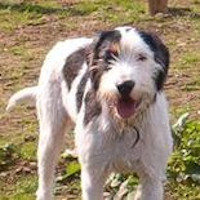Appearance of the Welsh Hound
|
| The appearance of a Welsh Hound is similar to that of a Foxhound, but instead of a smooth covering, it has a stiff, medium-length coat. As befits a dog that moves quickly over rough terrain, the Welsh Hound has an athletic yet robust build. Like many dogs bred for work, they have a good-length muzzle, allowing them to breathe easily and pant as required by the demands of rigorous exercise. They have floppy ears that hang over the cheek, but do not have the excessive length of some scent hounds. The Welsh Hound is a robust dog with a straight tail that is carried high but never curled. The tip of this tail is a landmark for hunters to follow. Their coat is coarse, offering protection from the ferns and broom that the dog may encounter while hunting. That said, while a coarse coat is the norm, the occasional Welsh Hound with a smooth coat is always welcome. The most typical coloring is white with patches of red, fawn, black or bronze. |
Temperament of the Welsh Hound
|
| When a dog is created as a working breed, the most successful dogs are chosen for selective breeding. This accentuates the traits considered desirable in the breed. In the case of the Welsh Hound, these include high energy, teamwork and a loud bark. The typical Welsh Hound is therefore happiest when part of an extended guard dog family in a pack. They are a happy dog and largely accept whatever circumstances they find themselves in, provided they receive plenty of exercise and mental stimulation. As sociable dogs, they don't do well if kept alone or confined for long periods. Their nature is such that they need constant social interaction and expect to be active most of the day. The other implication of their natural love of hunting is that they tend to have a stubborn streak. When they're on the trail of an interesting scent, they're likely to devote themselves fully to it and go where the will takes them. This can make training a challenge, especially for an inexperienced owner. On the positive side, the Welsh Hound is not an aggressive breed. It is a sociable dog and thrives in the company of other dogs, which is great for those who have the opportunity to have a large household of dogs. |
Needs and activities of the Welsh Hound
|
| The Welsh Hound is a highly intelligent dog, but it's also very energetic and requires plenty of activity every day. These dogs are social and like to spend time playing with other dogs. Daily visits to the local dog park are a great way to run and play with other dogs if they don't have another dog at home. Dog meets also work well if you don't have a dog park nearby. The Welsh Hound is not a good choice for apartment living, as they are very vocal and bark incessantly when left alone for too long. They will also become destructive if not given the opportunity to stretch their legs. |
Maintenance of the Welsh Hound
|
| The Welsh Hound has a dense, shedding coat, which means it's not a hypoallergenic breed and needs regular grooming to keep it in good health. Their coat requires weekly brushing with a smooth brush or even a natural bristle brush. A metal comb may be needed to remove tangles from their medium-length coat. They shed seasonally. During these periods, be sure to brush them more often to prevent hair from gathering around the house. They have a hard coat that should repel dirt, so they shouldn't need to be bathed often. When bathing, be sure to use a hard coat shampoo and don't over-condition their coat, as this will soften it too much. Being a dog with hanging ears, make sure you clean their ears every week. Dry their ears carefully to avoid infection. Trim the hair between the pads of their feet and trim their nails if necessary. |








 English (United Kingdom)
English (United Kingdom)